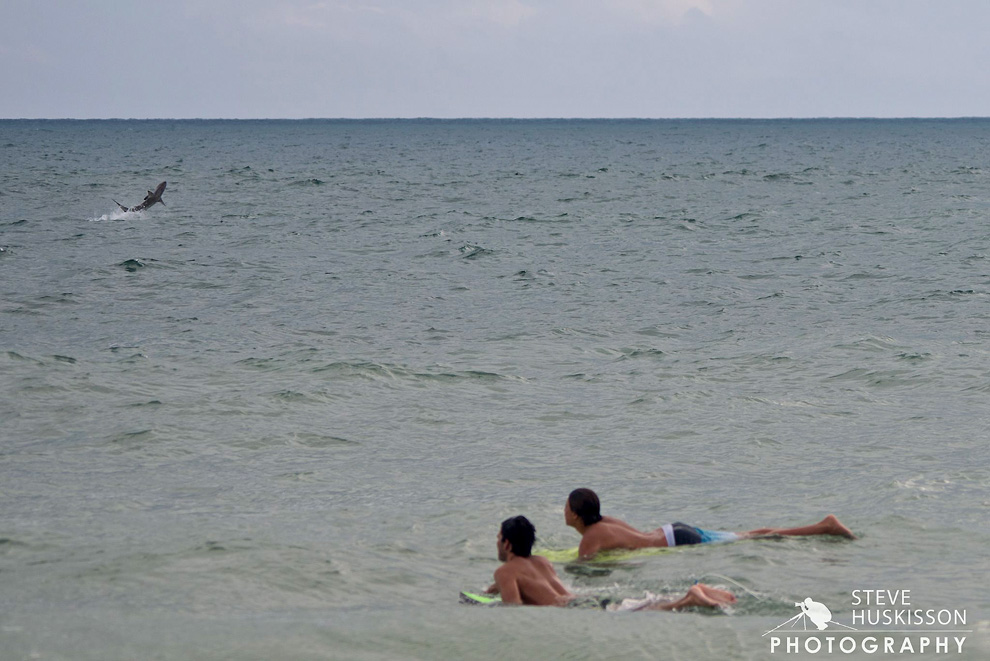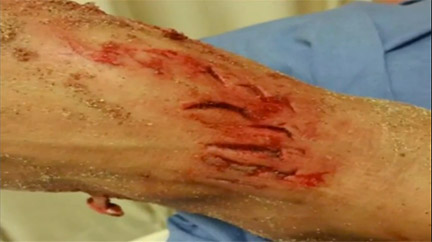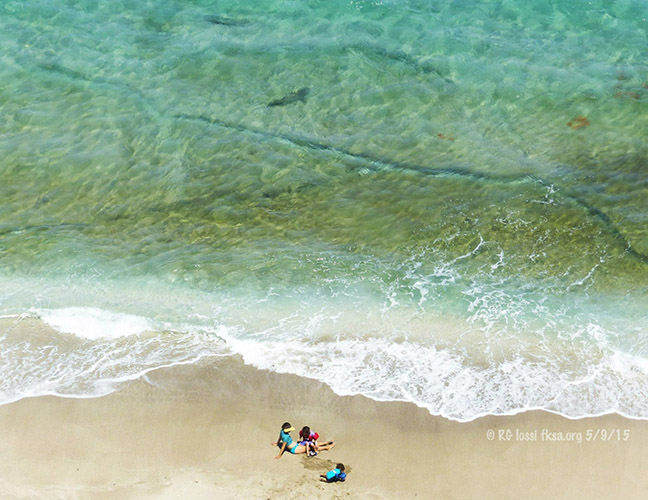
 |
|
|
|
#1
|
||||
|
||||
|
I communicated with graduate student Shari Tellman working under Professor Stephen Kajiura on the areal shark video survey. She told me that they have been performing a study of the blacktip shark population off Palm Beach County between February 2011 and March 2013. They hope to acquire baseline abundance data for comparison to findings in future studies to monitor environmental effects such as climate change on the distribution and relative numbers of this important apex predator.
She indicated that the blacktips, very similar to appearance to spinner sharks but still a different species, migrate south into Broward and Miami-Dade Counties in the fall. The sharks remain offshore in deeper water in the fall and early winter. This may account for the lower quantities of sightings spread out in deeper, sometimes turbid water. Then in the spring they migrate northward to Georgia and the Carolinas to breed. In their survey they have noticed sharks to be prevalent off Palm Beach county in late January into early March. So, the appearance of masses of sharks south of Lake Worth Inlet at this time of year isn't unusual.  A figure provided by Ms. Tellman showing the narrow shelf off Palm Beach County compared to points south. Ms. Tellman indicated that the sharks follow and prey upon large schools of baitfish such as mullet which in large measure explains their distribution at various times of the year. She indicated that the narrow continental shelf off Palm Beach County serves to concentrate larger masses of sharks closer to shore. Adding in the better water visibility and influence of the Gulfstream under certain conditions, the sharks are even more noticeable than they might be spread out in more turbid waters in the two southern counties. I had wondered about the appearance, disappearance and eventual reappearance of the shark aggregations off beaches in Palm Beach County. Specifically I was curious about significant factors influencing shark local distribution during the migration. She responded the nearshore distribution of the blacktips is patchy and speculated it may be attributable to food availability and sea state. In heavier seas the sharks may move to deeper water to where they may be less noticeable. Where there is an abundance of baitfish the sharks may be quite concentrated. I asked if they had impressions about the relative abundance of larger sharks such as bulls and tigers escorting and feeding upon the blacktip migration. She stated that their video imaging doesn't allow for identification of various shark species but that larger individuals were noted which might be bull and tiger sharks. I want to thank Shari Tellman for taking the time to provide detailed responses to my questions and wish them all success with their study and eventual publication. What follows are some personal observations. So, the migration is on, have a care out there. Fatal shark attacks on kiters worldwide are infrequent. Certainly they are far less common that squall/wind related fatal kiting accidents. Then again, what percentage of the global kiter population ride in shark migrations for extended periods of time such as may be the case off here and now. By comparison, shark attacks on surfers are far more common particularly in Florida. I understand from other sources that our "taste" isn't to most shark's liking, not "fishy" enough. Blacktips may strike and then leave particularly in conditions of poorer visibility. Usually the injuries have been fairly minor with the smaller shark size and fleeting presence. Apparently we aren't on the favorites list with bulls or tigers either. The problem is a larger shark/bite radius the more damage that can be done. The location of the bite is also particularly relevant. Sharks may strike your thigh area to apparently disable locomotion, putting your femoral artery at risk as has happened in a number of severe attacks in various parts of the world. Multiple bites further compound the injury if such occurs. Remember the sharks chasing the kiter after transitions. Also, if you bust a landing near a shark or slide off your strapless board it may strike out of impulse then move on or it may just ignore you entirely. It is fair to say, the odds of a negative encounter increase kiting during the migration, in areas with visible sharks, in areas with jumping bait and feeding birds and in my personal experience, near sunset. How much do they increase, who knows? For my part if there are visible shark signs of the migration, I will probably not go kiting at that location, at that time. It doesn't remove risk but it may serve to reduce it. It is worth thinking over.  Blacktip sharks http://en.wikipedia.org/wiki/File:C._limbatus.JPG .
__________________
FKA, Inc. transcribed by: Rick Iossi Last edited by ricki; 01-25-2013 at 01:14 PM. |
|
#2
|
||||
|
||||
|
Yeah...I'm with you Rick on passing on the opportunity to kite with thousands of sharks. Last week in 18 kt winds the wind INSTANTLY died and my kite fell straight out of the sky. No warning...not even a slight lull. Straight up cut off like someone flipped a switch. It picked back up literally 10 seconds later but by that point I was already in a channel and had to wait for the kite to drift into the wind window before I could power it up again.
Imagine that scenario on top of this many sharks. Game over. |
|
#3
|
||||
|
||||
|
Attacks on kiters are very rare, even more so while on plane. Then again, the population of kiters riding in the migration is pretty small so the odds of problems likely differ. On the other hand attacks on surfers are fairly common. Once you go into the water, you become fairly surfer-like. So I agree with your concerns about going into the water for an extended period. Surfers do it, many have no problems, some are bitten though. Most kiter attacks seem to have happened with kiters in the water and off plane. It is all about awareness and choices. I will still kite down here during the migration just not in massive schools of blacktips any more or if there are obvious signs of shark activity, diving birds, jumping bait fish, etc..
__________________
FKA, Inc. transcribed by: Rick Iossi |
|
#4
|
||||
|
||||
|
Cole Taschman, a 16 year old surfer was bitten on the hand at Bathtub Reef on Feb. 9, 2013. He was just entering the water to go surfing and was in about waist deep water when he estimated a 4 to 5 ft. shark hit his hand. He was fortunate the damage was pretty limited as you can see below but did receive 12 stitches to close the wounds.
He was surfing for a fund raiser for a former neighbor of mine, Brooke Thabit who was paralyzed in a diving accident. More about the attack including photos (shown below) and a video at: http://www.palmbeachpost.com/news/ne...shark-b/nWMGm/ and more about Brooke at: http://www.fksa.org/showthread.php?p=50577   The victim, Cole surfing recently. (Photos from Palm Beach Post)
__________________
FKA, Inc. transcribed by: Rick Iossi Last edited by ricki; 02-12-2013 at 03:22 AM. |
|
#5
|
||||
|
||||
|
I heard from Professor Kajiura from FAU in regard to the Blacktip migration. He had been traveling extensively in recent weeks. The professor offered a few comments in addition to the information provided by his graduate student, Shari Tellman. He added that between the close proximity of the Gulf Stream to shore and presence of calm water allows the blacktips to mass at times close to shore. He also observed that the presence of large numbers of blacktips nearshore in Palm Beach County may be a little late this year due to the unusually warm winter conditions so far this year.
Their important research has run out of funding and so will end this spring. This is unfortunate as there is still more to learn about this important shark species and the migration. Continued research might even impact the occurrence of attacks such as suffered by young Cole Taschman in time.
__________________
FKA, Inc. transcribed by: Rick Iossi |
|
#6
|
||||
|
||||
|
Heads up, the northbound blacktip shark migration is back for 2014.
 Photographer Steve Huskisson posted the following image from Juno Beach and comments on his Facebook page today. "Waves, surfers, paddleboards and sharks... Yes sharks. Headed over to walkway 36 and met up with Lori Griffith and Jeffrey Barron Biege to shoot some surfing. The Spinner Sharks were plentiful and I was content on shooting surfers until Lori said "get a shot with a shark in it..." Last time I take on that challenge. I stood, fixated on the ocean beyond the surfers waiting and watching shark after shark to my left and right jumping. Captured plenty of after splashes of the sharks. Finally, one decided to jump where I was waiting. Here you go Lori, your shark..... No photoshop, just patience and a lot of shutter clicks of missed sharks. More of today's surf & paddle boards from Juno Beach, Coral Cove and Walkway 36 to come. " https://www.facebook.com/shuskisson Some related comments from the Sunsentinel: "South Florida Is About To Be Swarmed By Sharks Sun Sentinel | By David Fleshler Posted: 11/28/2013 3:55 am EST | Updated: 01/27/2014 5:59 am EST Thousands of blacktip and spinner sharks will swim into South Florida in the next few weeks in an annual migration that yields spectacular aerial videos and occasional beach closures. Up to 15,000 have been counted on a single day off Palm Beach County by scientists from Florida Atlantic University, and these just represent the ones visible from one flight along the coast. Like birds and manatees, the sharks come south for the winter, arriving in December and January, with numbers peaking in late January and early February. "When they're there, you can walk on them," said Josh Jorgensen, of Singer Island, director of the Blacktip Challenge, a five-day catch-and-release tournament along Florida's east coast that tags sharks for scientists. "I remember one time last year there must have been 500 that swam by in an hour, endless blacktips. They were 20 or 30 feet off the beach." The sharks swim as far south as southern Broward or northern Miami-Dade County, said Stephen Kajiura, associate professor of biology at FAU, who has studied the migration. They head north in March, reaching as far as North Carolina. Scientists say the danger to people is low, despite scary aerial videos that show vast swarms of sharks within yards of clueless swimmers. Blacktips and spinners, which typically reach lengths of five or six feet, eat mullet, grouper, snook and other fish, nothing as large as a human being. "Those sharks are 100 or 200 yards away from thousands of bathers and they show no interest in them at all," said Brent Winner, research scientist for the Florida Fish and Wildlife Conservation Commission" Continued at: http://www.huffingtonpost.com/2013/1...n_4353745.html .
__________________
FKA, Inc. transcribed by: Rick Iossi |
|
#7
|
||||
|
||||
 At the public beach at the south end of Singer Island I've seen about 10 black tip sharks jump in as many minutes. They are too far offshore to catch with an iPhone unfortunately. They have closed the public beach to swimming. They took about a 20 minute break and the started spinning again. I think I saw three go together at the same time. If they are trying to panic and stun bait, it makes sense to go in groups. A guy who works at a concession on the beach there said the sharks had been visible for about four days so far this season at Singer Island.
__________________
FKA, Inc. transcribed by: Rick Iossi Last edited by ricki; 02-09-2014 at 09:26 PM. |
|
#8
|
||||
|
||||
 http://www.towleroad.com/2008/07/jumping-the-sha.html GRAPHIC INJURY PHOTOS FOLLOW The blacktip sharks migrate south in the late fall to Broward and Miami-Dade Counties and then head back north to the waters off the Carolinas in January to April to give birth. For some reason many of the incidents you hear about occur during the northerly migration. A surfer was bitten on the foot near the Deerfield Beach Pier, apparently by a five foot spinner or blacktip shark. The surfer didn't notice evidence of sharks in the area and was about 50 yards off the beach when his foot was struck. A five foot spinner shark then launched out of the water nearby spinning. He received 50 stitches to close the lacerations.   More at: http://www.sun-sentinel.com/local/br...019-story.html Spinner and blacktip sharks aren't fond of the way we taste apparently, given the frequency in Florida of non-fatal, bite and run attacks like this. Still, when bait are running particularly during some of the larger migrations like the bluefish at present, sharks are likely following along in numbers. The shark may strike, decide it wants something fishier and moves on. The severity of the damage depends in large measure what is bitten and how intensely. Then there are the larger sharks which may prey upon the often smaller spinner and blacktip sharks following the bait migrations as well like hammerheads, tigers and bull sharks. The bite radius alone even in the case of a bite and run attack with these larger and at times more aggressive species can be far more dangerous given the amount of tissue damage that may be involved. Kiteboarder Steve Schafer died as a result of severe vascular wounds suffered off Stuart, FL in 2010 likely from a bull or tiger shark bite during the blacktip/spinner migration.  No joy for me at Boynton Inlet although the birds and fishermen seem to be having a good time. Like many kiters I have been taking full advantage of this great first bout of wind we've been having in South Florida. Yesterday I was going to head off the Boynton Inlet but was dismayed to see a mass of seagulls and bait clouding the water right at the mouth of the cut. Lots of fishermen were pulling in bluefish as fast as they could cast their lines out. Looked like shark sign to me big time, so I headed further south. I stopped at a park almost a mile south and spoke to a kiter who had just come off the water. He said the bluefish were pretty thick off there being chased by some monster tarpon. He didn't see any sharks but unless they are spinning you often never do but they are likely still there.  Kiting last night off Hillsboro Inlet. Ironically, that could be a small shark about 40 ft. ahead of me slightly off to the right on a diagonal. I have picked up sharks before when I ran close to the north jetty and caught them on the kite camera. I went all the way to Pompano and had a session seeing little bait except for a small pocket inside the south jetty of Hillsboro Inlet. Still, there are sharks frequently around all inlets and this one is no exception. I just didn't see a lot of bait, feeding birds, etc., yet. Still, as the photo below shows sharks can swim along at anytime in these waters. Fortunately, they usually ignore us. I tried to photograph them in the water but they always swam off out of visible range. Perhaps in the heat of chasing migrating bait they may get a bit worked up.  So, have a care out there. Avoid bait being worked evidenced by jumping fish, sea birds, spinning sharks, etc.. The reality is that attacks can occur outside of such areas. All you can do is use common sense to try to reduce the odds. Staying out of the water and on plane may help. Most of our problems in past years seemed to have happened when kiters are in the water and off their boards.
__________________
FKA, Inc. transcribed by: Rick Iossi Last edited by ricki; 10-21-2015 at 04:32 PM. |
|
#9
|
||||
|
||||
 From: KRISTA SIMPSON via http://www.tcpalm.com/ An update on the migration from the Sunsentinel. I believe this is the southerly migration of spinner sharks which precedes the more well publicized northerly movement in the spring. The article doesn't discuss larger sharks such as bulls, tigers and hammerheads which escort the migration which reportedly were responsible for Steve Schafer's fatal accident while kiteboarding off Stuart, FL in the spring migration of 2010..  From: http://www.wptv.com/ "By David Fleshler, Sun Sentinel November 30, 2013 Thousands of blacktip and spinner sharks will swim into South Florida in the next few weeks in an annual migration that yields spectacular aerial videos and occasional beach closures." "The sharks swim as far south as southern Broward or northern Miami-Dade County, said Stephen Kajiura, associate professor of biology at FAU, who has studied the migration. They head north in March, reaching as far as North Carolina. Scientists say the danger to people is low, despite scary aerial videos that show vast swarms of sharks within yards of clueless swimmers. Blacktips and spinners, which typically reach lengths of five or six feet, eat mullet, grouper, snook and other fish, nothing as large as a human being." More at: http://www.sun-sentinel.com/news/pal...,3721824.story More about the migration from http://www.tcpalm.com at : http://www.tcpalm.com/news/2013/oct/...t/?partner=RSS  From: Spinner off Juno Pier, Photo: Nadja Neptune via http://www.wptv.com/ Channel 5 has an article on how to tell the difference between spinner and blacktip sharks, both which can be present in quantity during the migration. They reported that the spinner shark has a black tip on the corner of their pectoral fin while ironically, blacktip sharks do not. More at: http://www.wptv.com/dpp/sports/recre...the-difference .
__________________
FKA, Inc. transcribed by: Rick Iossi Last edited by ricki; 12-01-2013 at 04:45 AM. |
|
#10
|
||||
|
||||
|
Migration seems to be back, recent aerial video at: https://www.facebook.com/33042648382...5903037944124/
"The aerial survey flight yesterday revealed that large numbers of sharks have now arrived in southeast Florida. This video clip was captured off Palm Beach, just south of the Palm Beach Inlet. Looking forward to tagging some blacktips tomorrow. This is a greatly downsampled clip; the original 4K video is much clearer."
__________________
FKA, Inc. transcribed by: Rick Iossi |
 |
|
|